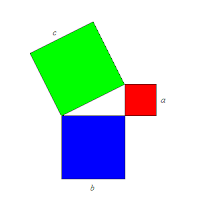6/06/2010 @ 2:07 PM
Measurement
In this unit, you will learn about the pythagorean theorem and the perimeter/area/surface area/volume of shapes and 3-D objects. 
First, there is the pythagorean theorem.
The equation for the pythagorean theorem is a² + b² = c²
c² is the hypotenuse side.
EXAMPLE: Side a = 2 Side b = 8
What is the measure of side c?
a² + b² = c²
(2)² + (8)² = c²
4 + 64 = c²
68 = c²
68 squared = c² squared
8.2 = c
Another thing we learned about is perimeter and area.
Here are the equations:
Rectangle
Perimeter: P= l + l + w + w OR P = 2 (l + w)
Area: A = lw
Parallelogram
Perimeter: P = b + b + c + c OR P = 2 (b + c)
Area: A = bh
Triangle
Perimeter: P = a + b + c
Area: A = bh/2 OR 1/2bh
Trapezoid
Perimeter: P = a + b + c + d
Area: A = (a + b)h /2 OR 1/2 (a + b)h
Circle
Circumference: C = πd OR 2πr
Area: A = πr²
Cylinder
Surface Area: SA=2πr²+2πrh
Volume: V=πr²h
Sphere
Surface Area: SA=4πr²
Volume: V=4/3 πr³
Cone
Surface Area: SA=πrs+πr²
Volume: V=1/3 πr²h
Square base pyramidArea: A=2bs+b²
Volume: V=1/3 b²h
Rectangular prism
Area: A=2(wh+lw+lh)
Volume: V=lhw
Triangular prism
Area: A=ah+bh+ch+bl
Volume: V=1/2 blh
PRACTICE:
1)
 What is the perimeter of this triangle?
What is the perimeter of this triangle?ANSWER: P = 9 + 5 + 11
P = 25
2) What is the area of a rectangle that has a length of 12m and a width of 4m?
ANSWER: A = lw
A = (12) (4)
A = 48m
3) Soda is sold in aluminum cans that measure 15cm in height and 6cm in diameter. What is the volume?
ANSWER: V=πr²h
V = (3.14)3² (15)
V = (3.14)9 (15)
V = 423.9 cm³
4)
Find the volume of this triangular prism.
V=1/2 blh
V= 1/2 (6.2) (4.3) (8.5)
V= 1/2 (226.61)
V= 113.30cm³
Another thing we learned about is the angle relationships in triangles.
The sum of the interior angles in a triangle is 180 degrees. Therefore, a + b + c = 180 degrees.
The sum of the exterior angles of a triangle is 360 degrees. Therefore, x + y + z = 360 degrees.
The exterior angle of each v ertex is equal to the sum of the two opposite interior angles, so x = b + c, y = a + c, and z = a + b. EAT (Exterior angle theorem)
A midpoint is a point that divides a line in half EQUALLY.
TIP: the formula for the sum of the interior angles of a regular polygon is 180 (n-2)
In any quadrilateral, when you connect the midpoints of the sides, a parallelogram/rhombus is formed.
Labels: Lessons
back to the top.
